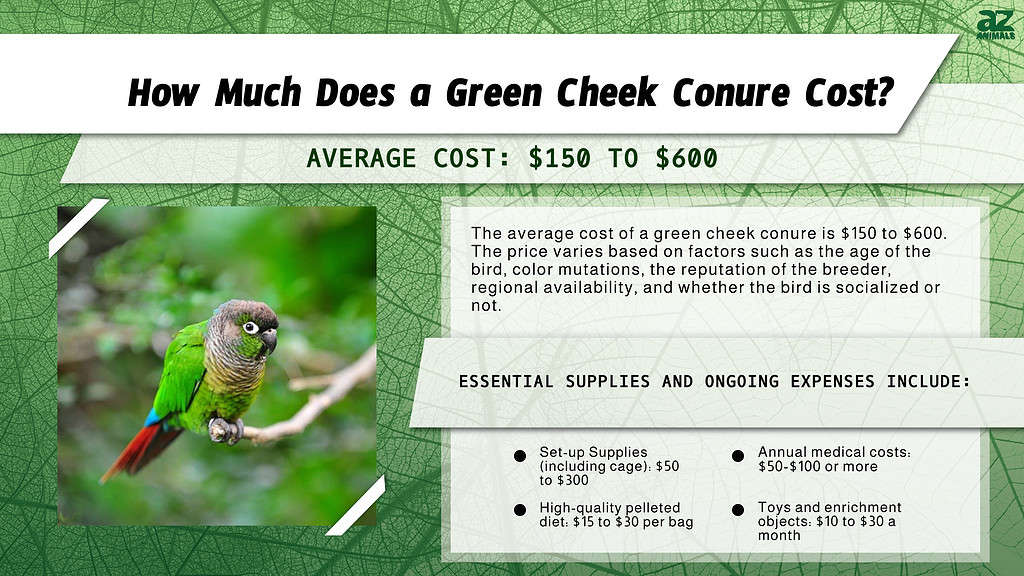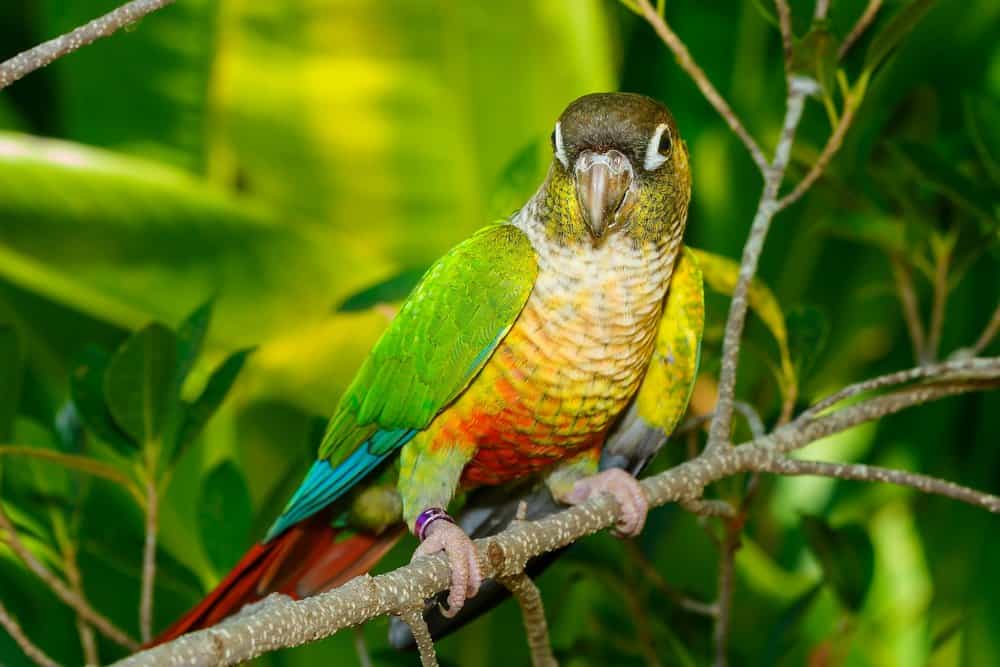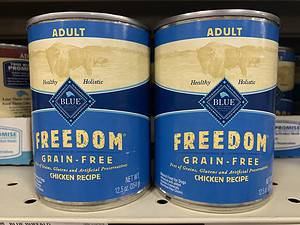Green Cheek Conures are one of the more expensive birds you can purchase. However, Green Cheek Conure prices can vary widely depending on your location and the bird’s age. A single bird often costs anywhere from $150 to $600.
However, you must also consider all the supplies and cage accessories required to keep these birds thriving. Bird cages can be extremely expensive, especially for one of these larger birds.
Introduction: Exploring the Popularity and Appeal of Green Cheek Conures as Pet Birds
Few creatures rival the charm of the Green Cheek Conure. These pint-sized parrots are a great option for bird enthusiasts thanks to their vibrant plumage and lively personalities. Thanks to their wide availability, they are one of the more popular pet birds.
These birds come in various colors, including pineapple, cinnamon, and turquoise. They have several distinct colorations, though some are more expensive than others.
These conures are smaller than other birds. Therefore, they are more suited to smaller spaces for those who want a parrot but don’t have enough room for larger species. Their compact statue doesn’t limit their personality, though. They are just as lively and affectionate as other parrots.
Generally, these birds are also pretty low-maintenance compared to other options. Their diet is straightforward if your particular bird will accept pellets, and their cages are often easy to manage.

Purchase Cost: Factors Affecting the Price Range of Green Cheek Conures
There are many factors that may affect the price of a Green Cheek Conure. One significant factor is the age of the bird. Babies are often more expensive because of their longer lifespan ahead of them. Furthermore, most owners looking for a bird are looking for younger birds, so there is a higher demand for them.
Adult birds may be easier for beginners, though, especially if they are on the tamer side.
Rarer color mutations are often popular, too. Therefore, they tend to be more expensive. You’re less likely to find these birds at pet stores, too, requiring you to go through a breeder.
Reputable breeders who specialize in Green Cheek Conures may charge more than pet stores or less reputable sellers. However, they often provide healthier, well-socialized birds that have been raised with proper care and nutrition. We recommend going with a breeder whenever possible.
In areas where these birds are rarer, they tend to be more expensive. Luckily, most areas in the US have these birds available, though there may be regional shortages that affect prices.
Breeders may vary widely in price depending on what they offer. For instance, breeders that spend time training their birds tend to charge more than those that only offer basic socialization. Some may also provide a starter kit containing a cage and toys, and they may charge more for this reason.

Conures are intelligent and noisy, often mimicking sounds and learning vocabulary.
©boyphare/Shutterstock.com
Supplies and Setup: Essential Supplies and Cage Setup for Green Cheek Conures
Before you bring your bird home, you must have a cage setup, including all the necessary accessories. A spacious cage is necessary. They should be at least 18 inches by 18 inches for a single bird. If you adopt multiple birds, the cage needs to be even bigger.
Provide horizontal bars for climbing, and ensure they are close enough together to prevent escape.
You’ll also need to purchase several perches for your bird. Choose different-sized perches to exercise your bird’s feed and prevent foot problems. Natural wooden perches are the best option, as they mimic the bird’s natural environment and often have different sizes along their length.
Food and water dishes are necessary, as well. Some cages come with these, but you’ll need to purchase a set if yours does not.
You’ll need to choose a lining for your bird’s cage, but many people choose newspaper (which is free and helpful).
You should choose a high-quality pelleted diet designed for conures for your bird. You can supplement with fresh fruits and veggies, but a pelleted diet will contain everything your bird needs to thrive. Many nut and seed diets are too high in fat and allow for picky eating (where the bird only eats the exact seeds it likes).
Ongoing Expenses: Cost of Food, Toys, Bedding, and Veterinary Care for Green Cheek Conures
You should choose a high-quality pelleted diet designed for conures for your bird. You can supplement with fresh fruits and veggies, but a pelleted diet will contain everything your bird needs to thrive. Many nut and seed diets are too high in fat and allow for picky eating (where the bird only eats the exact seeds it likes).
A bag of quality pellets can cost around $15 to $30 and may last several weeks to a few months. Therefore, this isn’t often a significant expense.
These birds are quite intelligent, as you may expect. You’ll need to purchase several toys and enrichment objects. This may cost between $10 to $30 a month, depending on the exact toys you select. It’s best to have several toys on rotation, as these birds can become bored easily.
You’ll also need to take your bird to the vet regularly. These regular visits help catch any diseases your bird may have before they become serious. Annual check-ups cost between $50 to $100 or more, depending on your location and the vet’s fees.
Budget for emergency expenses, as well. Illness and injury can vary widely in cost. They may range from $100 to thousands, depending on exactly what is wrong with your bird.
You’ll also need to purchase bird-safe disinfectants and cleaning brushes. However, this isn’t typically very expensive. They may cost around $5 to $10 per month.
Budgeting Tips: Budgeting for Green Cheek Conure Ownership and Making Informed Decisions when Purchasing or Adopting
While owning one of these birds can be rewarding, it can also be expensive. They have a long lifespan, so you should be prepared to dedicate up to 20 years to your bird’s care. The initial purchase price is a small part of the bird’s overall expenses.
Plan to invest in high-quality items from the start, as this can help save money in the long run. For instance, if you purchase a more expensive cage, it may last you longer and save you money down the road.
You can also choose DIY toys and enrichment activities, which may cost less. Higher-quality toys can also be helpful, as these may last longer overall.
Scheduling regular checkups with your vet can also be helpful, as these ensure you catch illnesses earlier when they are cheaper to treat.
The photo featured at the top of this post is © aee_werawan/iStock via Getty Images
Thank you for reading! Have some feedback for us? Contact the AZ Animals editorial team.







